Compare Apple M4 and Snapdragon X Elite
Apple has once again surpassed Qualcomm by releasing its latest chipset, the Apple M4, before the Snapdragon X Elite launched. The new Apple M4 chipset was introduced alongside the iPad Pro OLED. Many people are interested in how the Apple M4 chipset differs from the upcoming Snapdragon X Elite processor for Windows PCs. So, in this article, let's take a close look at the CPU, GPU and NPU/Neural Engine and try to find the #1 consumer chipset.
Compare specifications of Apple M4 and Snapdragon X Elite
Take a look at the specs comparison between Apple M4 and Snapdragon X Elite to understand the difference between the two chipsets.
| Apple M4 | Snapdragon X Elite | |
|---|---|---|
| Fabrication process | TSMC's 2nd generation 3nm | TSMC's 4nm |
| Transistors | 28 billion | Don't know |
| CPU core | 9 CPU cores 3 performance + 6 efficiency 10 CPU cores 4 performance + 6 efficiency | 12 CPU cores 8 performance cores + 4 efficiency cores 10 CPU cores (Snapdragon X Plus) 6 performance cores + 4 efficiency cores |
| GPU core | 10 GPU cores HW Ray Tracing HW Mesh Shading | 6 Adreno GPU cores (possibly) 4.6 TFLOPs |
| Tons of numbers | Up to 4.4GHz | 3.8GHz; Dual core acceleration up to 4.2GHz + 3.4GHz; Dual core acceleration up to 4.0GHz + 3.4GHz (X Plus); No dual core boost |
| TDP | Don't know yet | 35W to 82W (possible) |
| Neural Engine | 16 cores; 38 TOPS | Hexagon NPU; 45 TOPS |
| RAM | 8GB and 16GB | Up to 64GB |
| Memory bandwidth | 120 GBps | 135 GBps |
| RAM type | Don't know yet | LPDDR5X |
| Other | AV1 decoding | AV1 encodes and decodes |
Apple M4 CPU and Snapdragon X Elite
Apple introduced the M4 chipset with the iPad Pro (2024) and currently, it only offers two variants: one with 9 CPU cores and another with 10 CPU cores. The M4 is built on TSMC's 2nd generation 3nm (N3E) process node which is promised to deliver better performance while improving efficiency. This is also the first consumer chip developed on the N3E node.
Apple has packed 3 performance cores and 6 performance cores in the first variant and 4 performance cores and 6 performance cores in the second variant. Although Apple has reduced the number of performance cores, it still increases the clock speed for the Apple M4 CPU at a powerful 4.4 GHz.
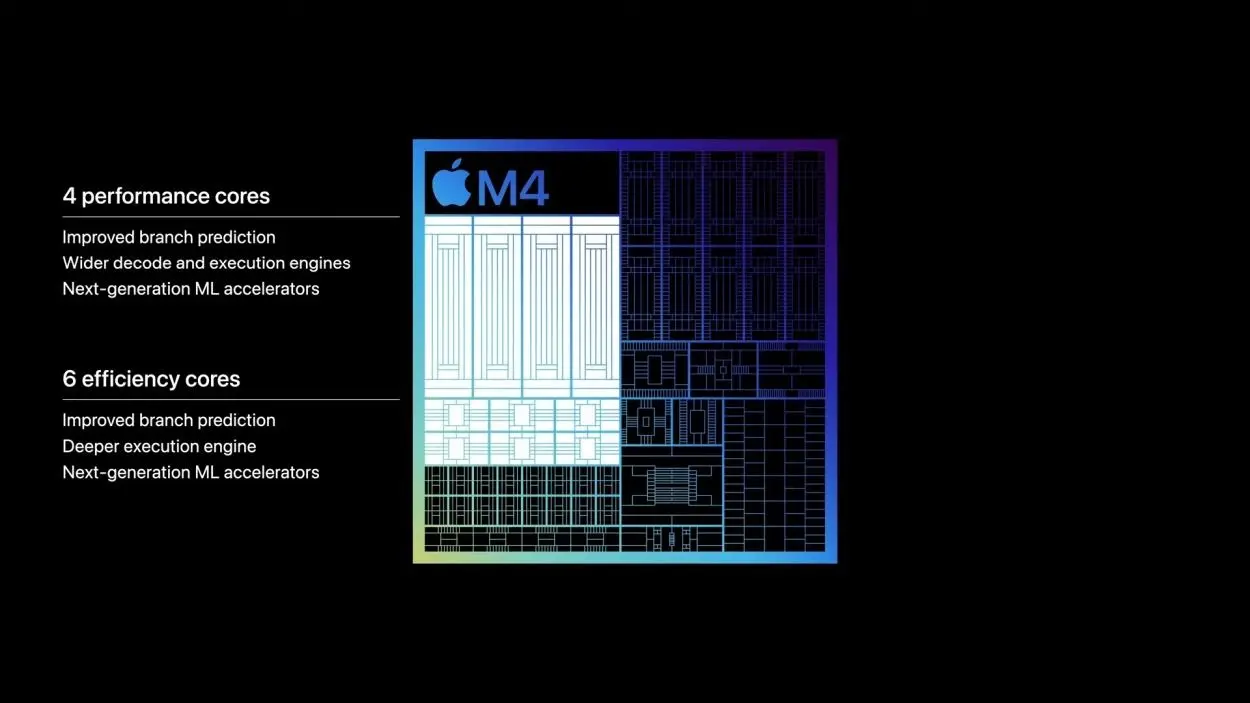
Snapdragon X Elite has 4 different variants: 3 variants with 12 CPU cores and 1 variant with 10 CPU cores, Snapdragon X Plus. Qualcomm PC chips are manufactured on TSMC's mature 4nm process node. Its highest frequency can reach 3.8 GHz, much lower than the maximum clock speed of Apple M4. Qualcomm also offers a dual-core boost of up to 4.2GHz on the top-end variant, but that's still lower than the M4's 4.4GHz clock speed.
If comparing the Snapdragon X Plus to the base Apple M4 (as both have 10 CPU cores), the Snapdragon to increase processing speed. In contrast, the base Apple M4 can reach peak clock speeds of up to 4.4 GHz, significantly expanding the frequency gap by 1000 MHz.
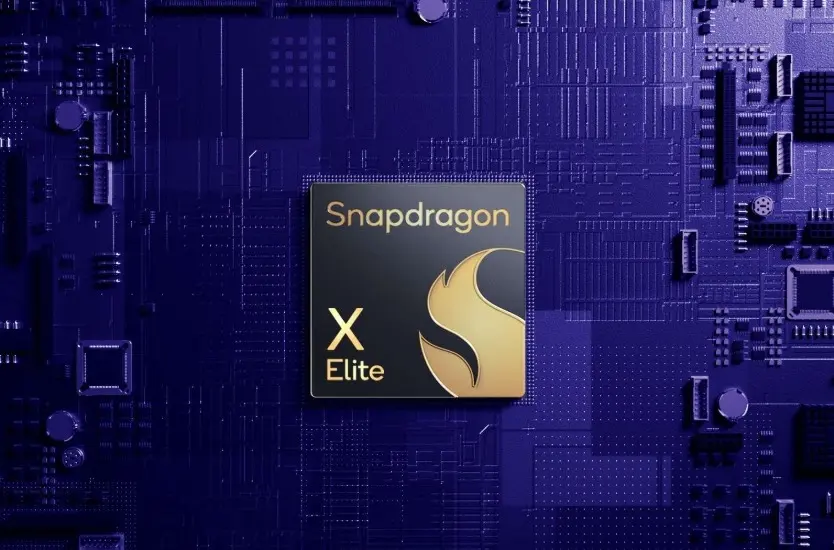
The performance difference is evident when comparing the Geekbench scores of both chipsets. Leaked Geekbench scores of the Apple M4 show it scoring 3,810 in the single-core test, outperforming all Snapdragon X Elite variants. The Qualcomm reference device running the top-end variant (X1E-84-100) scored 2,944 points in the single-core test. And the upcoming Samsung Galaxy Book4 Edge (X1E-80-100) scored 2,785 points in the single-core test.
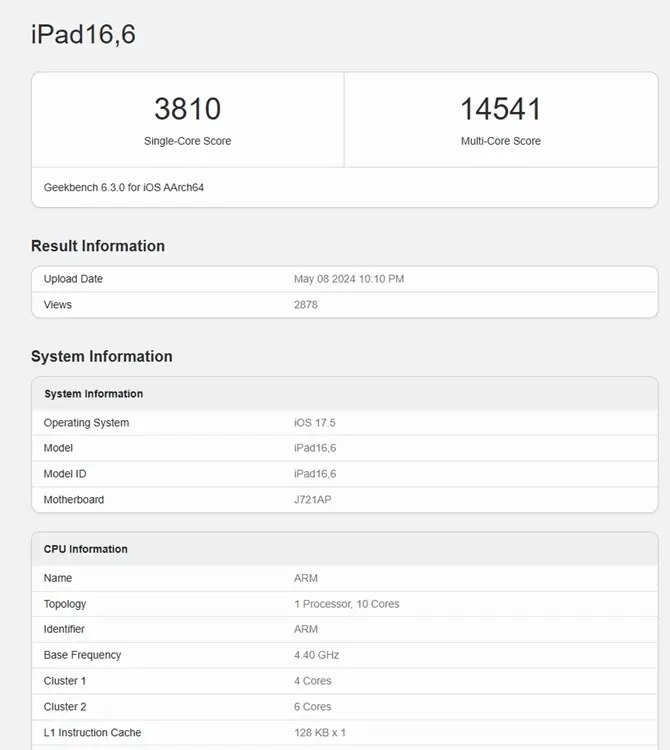
There is a performance difference of 23% and 37% respectively when compared to the top two Snapdragon X Elite variants. Remember that the article is comparing the base Apple M4 on a slim iPad with the top Snapdragon X Elite variant which is said to consume over 80W, requiring adequate cooling. And yet, the Apple M4 also defeated Qualcomm's Oryon-based PC chipset with an overwhelming margin.
| Single-core | Multi-core | |
|---|---|---|
| Apple M4 (10 cores, 4P+6E) | 3,810 | 14,541 |
| Snapdragon X Elite (X1E-84-100) (12 cores, 8P+4E) | 2,944 | 15,422 |
| Snapdragon X Elite (X1E-80-100) (12 cores, 8P+4E) | 2,785 | 13,925 |
In multi-core testing, the base Apple M4 scored 14,541 points with just 10 CPU cores (4P + 6E) while the top-end Snapdragon X Elite variant has 12 CPU cores and twice as many performance cores (8P + 4E), reaching 15,422, leading with a profit margin of 6%. When compared to the X1E-80-100 variant (13,925 in multi-core), Apple again leads by 4%.
It's clear that Apple has once again demonstrated its superiority in the field of chip design. The Apple M4 CPU is high-performance while consuming less power, and the performance-per-watt of the M4 is off the charts. It's unknown whether these improvements can be attributed to the ARMv9 architecture or TSMC's N3E process node, but Apple is significantly outperforming Qualcomm in the CPU category.
Apple M4 and Snapdragon X Elite GPUs
Coming to the GPU, Apple has built on the next-generation GPU architecture introduced with the M3 series last year. Apple M4 has 10 GPU cores and delivers industry-leading features like hardware-accelerated Ray Tracing and Mesh Shading for rich gaming experiences. It also supports dynamic caching for better GPU utilization.
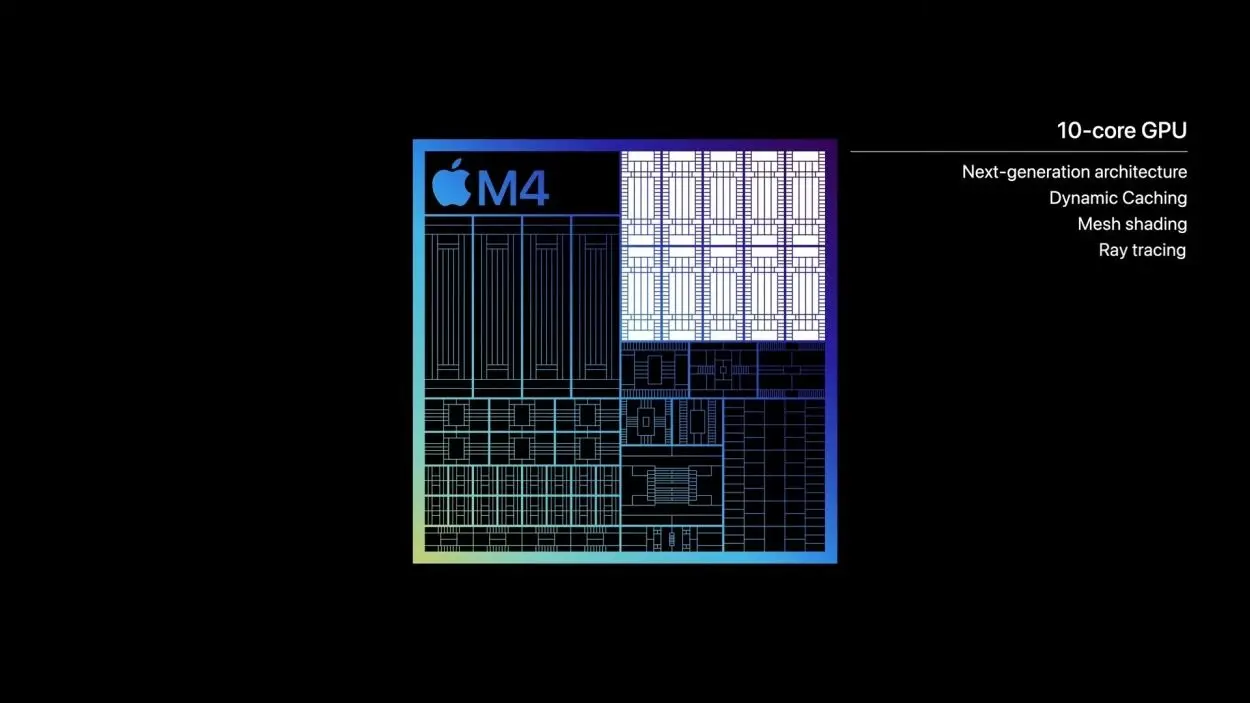
On the other hand, the Adreno GPU on Snapdragon X Elite is said to have only 6 GPU cores. This is definitely a weaker GPU when compared to Apple's M series GPUs. The Adreno GPU also does not offer HW accelerated Ray Tracing.
Qualcomm says its Adreno GPU can reach up to 4.6 TFLOPS on the top-end X Elite variant. While Apple hasn't revealed numbers for the M4 GPU, the older M2 GPU (10 cores) can deliver up to 3.6 TFLOPS. And according to Apple, the new M4 GPU is nearly 4 times more powerful than the M2 GPU.
The improvement may not be reflected in the compute scores, but Apple's GPU on the M4 is really strong and Qualcomm needs to upgrade the GPU.
Apple M4 NPU and Snapdragon X Elite
Next, we come to the NPU, or as Apple says, the Neural Engine. The M4 Neural Engine has 16 cores and it can perform up to 38 trillion operations per second (TOPS). In this regard, the Hexagon NPU on the Snapdrag0n X Elite can deliver up to 45 TOPS, which means Qualcomm is the leader in AI computing.
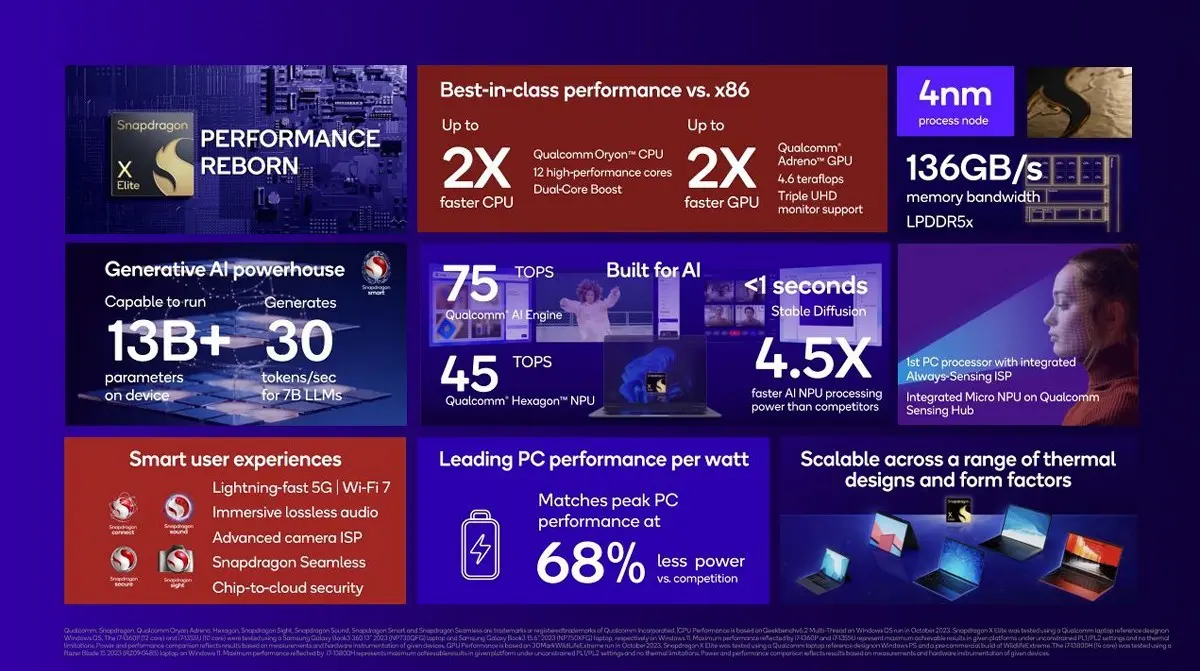
However, the TOPS number is meaningless without considering the type of operation and accuracy. Qualcomm's 45 TOPS figure is based on INT8 (8-bit integer operations), and Apple has also calculated 38 TOPS on INT8, as Ben Bajarin confirmed. That means Qualcomm has actually surpassed Apple in the AI computing race.
Besides hardware power, it should be noted that software optimization and memory bandwidth play an important role in getting the most out of the NPU. At this time, Apple has developed the MLX and CoreML framework for Apple Silicon to take advantage of the Neural Engine and it is also being widely used by developers. Qualcomm is working hard on its AI Stack, but needs more support and optimization after the X Elite launches.
Memory bandwidth
The base Apple M4 has a memory bandwidth of 120 GB/s while the Snapdragon X Elite supports LPDDR5X memory that can deliver speeds of up to 135 GB/s. The upcoming M4 Pro, Max and Ultra variants will obviously offer better speeds, but if you compare the base variants, you'll get slightly better memory speeds on the Snapdragon X Elite.
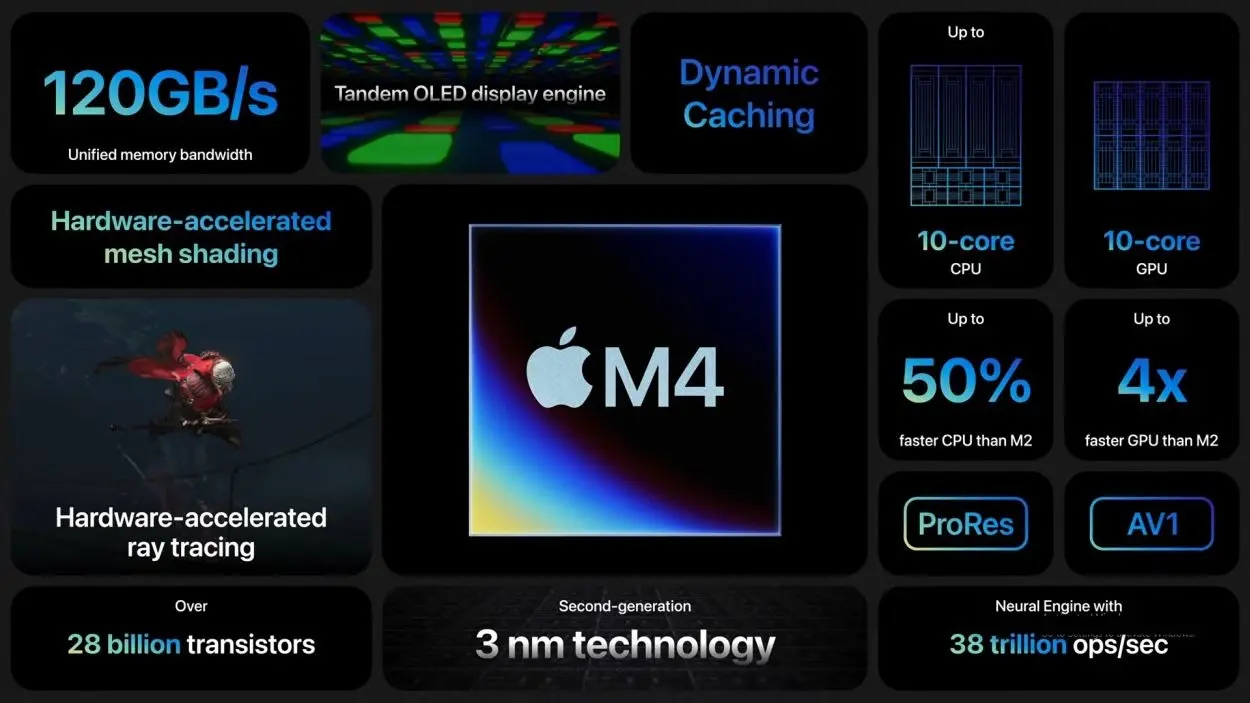
Additionally, Apple has also supported hardware-accelerated AV1 decoding in the M4's Media Engine, but it doesn't yet have AV1 encoding. On the other hand, Qualcomm has added both AV1 encoding and decoding on the Snapdragon X Elite. This video decoder consumes less power when watching high-resolution videos.
Conclude
Apple decided to release the M4 chipset just before the expected launch of the Snapdragon x86 vendors such as Intel and AMD.
And from the analysis, it can be concluded that Apple M4 has a significant lead in both CPU and GPU performance. The Snapdragon X Elite is the M3's closest competitor, but it's still a long way behind the M4. In particular, in terms of performance per watt, Apple has shown superior efficiency compared to the competition. However, in the NPU department, the Snapdragon X Elite packs a punch.
You should read it
- Visit the 8 most majestic stores in the world of Apple
- Fix Apple ID error disabled
- 12 interesting products for Apple
- Will Apple's slander 'i' disappear?
- Create an Apple ID, register an Apple ID account for less than 3 minutes
- How to change Apple ID password?
- Apple is about to encroach into the creative AI segment with the 'super project' Apple GPT
- How to Set Up Apple TV
May be interested
- Why should you buy a MacBook instead of a Snapdragon X Elite Windows laptop?
 for anyone considering a new arm laptop in 2024, the macbook and the snapdragon x elite laptop are two popular options.
for anyone considering a new arm laptop in 2024, the macbook and the snapdragon x elite laptop are two popular options. - Will there be Snapdragon X Plus with 5G Modem for Windows?
 previously, there was news that qualcomm is not only launching the snapdragon x elite chipset for windows pcs but is also developing a new variant called 'snapdragon x plus'.
previously, there was news that qualcomm is not only launching the snapdragon x elite chipset for windows pcs but is also developing a new variant called 'snapdragon x plus'. - Compare Snapdragon 8s Gen 3 and Snapdragon 8 Gen 2
 this is a benchmark comparison between snapdragon 8s gen 3 and snapdragon 8 gen 2, including geekbench, antutu, cpu throttling test, etc.
this is a benchmark comparison between snapdragon 8s gen 3 and snapdragon 8 gen 2, including geekbench, antutu, cpu throttling test, etc. - Samsung revealed the first Snapdragon X Elite laptop
 samsung officially entered the laptop market using qualcomm's snapdragon x elite chip, marking a new step in their galaxy book product line.
samsung officially entered the laptop market using qualcomm's snapdragon x elite chip, marking a new step in their galaxy book product line. - There were performance points of the Snapdragon 8150, which were strong but still lost to the Apple A12
 recently snapdragon 8150 chip performance point, qualcomm's most powerful chip has appeared, enabling us to compare its speed with other chips.
recently snapdragon 8150 chip performance point, qualcomm's most powerful chip has appeared, enabling us to compare its speed with other chips. - Exclusive processing platform on Copilot+ PC era
 microsoft and several major device manufacturers (oems) have announced the copilot+ pc line, all powered by qualcomm's snapdragon x processor.
microsoft and several major device manufacturers (oems) have announced the copilot+ pc line, all powered by qualcomm's snapdragon x processor. - Samsung loses bid to produce Qualcomm Snapdragon 8 Elite 2 chip, semiconductor sector sinks further into crisis
 samsung once again missed out on becoming qualcomm's top chip manufacturing partner.
samsung once again missed out on becoming qualcomm's top chip manufacturing partner. - REDMAGIC 10 Pro launched globally: Superior power with Snapdragon 8 Elite, 7,050mAh battery
 on december 3, 2024, redmagic 10 pro was officially launched with a series of improved technologies, bringing unlimited power to global gamers.
on december 3, 2024, redmagic 10 pro was officially launched with a series of improved technologies, bringing unlimited power to global gamers. - Snapdragon 865 and Apple A13: What will be the world's most powerful mobile CPU?
 865 snapdragon and apple a13, which cpu has more impressive performance?
865 snapdragon and apple a13, which cpu has more impressive performance? - Windows laptops are about to bring what MacBook users dream of
 qualcomm is exploring the possibility of introducing a new component for windows laptops that costs less than the snapdragon x elite called snapdragon x plus.
qualcomm is exploring the possibility of introducing a new component for windows laptops that costs less than the snapdragon x elite called snapdragon x plus.









 What is Tandem OLED on the new iPad Pro M4?
What is Tandem OLED on the new iPad Pro M4? Huawei's rising laptop business is threatened because the US withdrew export licenses with Intel and Qualcomm
Huawei's rising laptop business is threatened because the US withdrew export licenses with Intel and Qualcomm Da Vinci Eye - Paint portraits like a professional artist
Da Vinci Eye - Paint portraits like a professional artist Chrome adds AI features that make common tasks easier
Chrome adds AI features that make common tasks easier It will soon be possible to use OneDrive in a browser without internet
It will soon be possible to use OneDrive in a browser without internet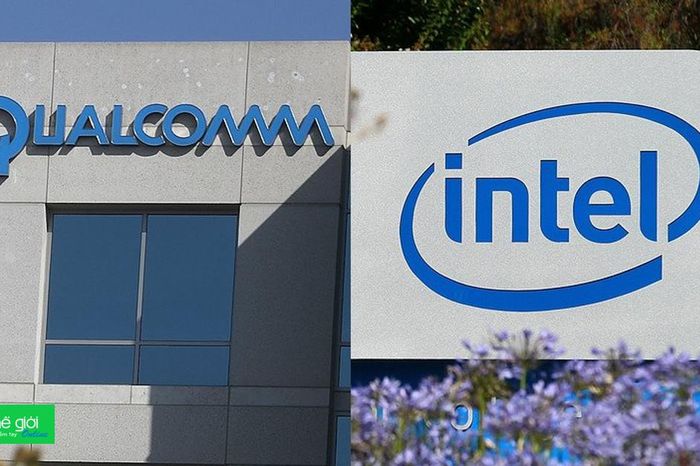 How will Intel and Qualcomm be affected when the US revokes chip export licenses to Huawei?
How will Intel and Qualcomm be affected when the US revokes chip export licenses to Huawei?